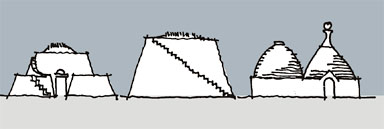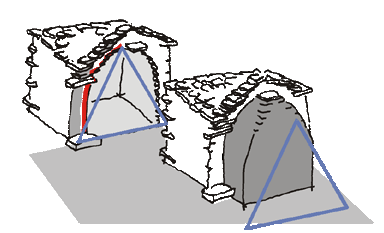|
Typology,
characteristics and particularity are elements of walls and
spatial constructions. The characteristic is the uniform internal
load bearing construction, which emerges from the circular
ground plan and triangular section. Particularities pertain
to the outer framework, where carved, semi-carved or completely
amorphous stones of large dimensions or stones ground to pebbles
or even sand are used. Even in-filling defines shape independently
of human desire. In other cases humans design the whole
or details purposely, thus enlightening stone constructions
with their own culture.
Therefore only the internal construction
is typical with the external form representing individual
work and fruition of the authors' creative drive. Something
is nevertheless common: the outer framework or coat can follow
the construction, move from it or withdraw completely, thus
taking over the role of form provider.
The most typical object of form
following construction, are the trulli in Puglia, clochan
in Ireland, crot in Graubuenden or caprile in Elba.
The Maltese girna is the
most diverse example of the coat not following the central
load bearing construction. Thus we have girnas with circular
or square ground plans, they are conical, round, graded or
curved. In Corsica the pagliaddiu has an emphasised roof projecting
outwards, similar are the barraco in Catalonia or kažun in
Istria.

| Diversity
in objects: pugliese trulli, but totally different
in the shape (Puglia, Italy) |
|
The only example of an opened perimeter,
which encircles the constructive multi-cell core, is the el
bombo in the La Mancha province in Spain. Form is provided
by the in-filled material, which can be neither controlled,
nor defined. It depends on the angle at which the in-fill
material slides downwards. This is the most natural form known
to us.
Special elements defining walls
and shelters are stairs. They can be added outside as consoles
or massive parts of walls, running along the perimeter spirally
or straight, built into the construction or added.
Special elements for internal flows are passages for humans
or openings for animals, whereby their sizes control movement.
Openings are typical features:
usually they are triangular or square thus simplifying construction.
Often they are combined with entrances, such as celestial
windows or incomplete niches used for storage inside. On the
outer wall niches are built as mangers for animal fodder.

| Inner
body, construction and frame: inner body has
typical corbelling in cross section, outside can
be seen just normal 'house' (Pagliaddiu (Corse),
France) |
|
In vernacular architecture
there are typically very few religious signs, but completing
elements of trullis are rather impressive. These are designed
with invention, individuality and exceptional effect, especially
because they are always given fresh coats of lime. These pinacoli
are also the most impressive details of vernacular
architecture.
|